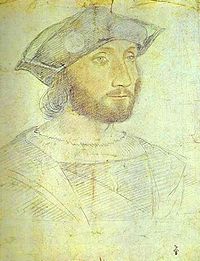
Guillaume Gouffier, seigneur de Bonnivet
Encyclopedia

France
The French Republic , The French Republic , The French Republic , (commonly known as France , is a unitary semi-presidential republic in Western Europe with several overseas territories and islands located on other continents and in the Indian, Pacific, and Atlantic oceans. Metropolitan France...
soldier.
The younger brother of Artus Gouffier, seigneur de Boisy, tutor of Francis I of France
Francis I of France
Francis I was King of France from 1515 until his death. During his reign, huge cultural changes took place in France and he has been called France's original Renaissance monarch...
, Bonnivet was brought up with Francis, and after the young king's accession he became one of the most powerful of the royal favourites. In 1515 he was made admiral of France
Admiral of France
The title Admiral of France is one of the Great Officers of the Crown of France, the naval equivalent of Marshal of France.The title was created in 1270 by Louis IX of France, during the Eighth Crusade. At the time it was equivalent to the office of Constable of France. The Admiral was responsible...
. In the imperial election of 1519 he superintended the candidature of Francis, and spent vast sums of money in his efforts to secure votes, but without success. An implacable enemy of the Constable de Bourbon
Charles III, Duke of Bourbon
Charles III, Duke of Bourbon was a French military leader, the Count of Montpensier and Dauphin of Auvergne. He commanded the Imperial troops of Holy Roman Emperor Charles V in what became known as the Sack of Rome in 1527, where he was killed.-Biography:Charles was born at Montpensier...
, he contributed to the downfall of the latter. In command of the army of Navarre
Navarre
Navarre , officially the Chartered Community of Navarre is an autonomous community in northern Spain, bordering the Basque Country, La Rioja, and Aragon in Spain and Aquitaine in France...
in 1521, he occupied Fuenterrabia and was probably responsible for the renewal of hostilities resulting from its not being restored.
Bonnivet succeeded Odet de Foix, Vicomte de Lautrec
Odet de Foix, Vicomte de Lautrec
Odet de Foix, Vicomte de Lautrec was a French military leader. He gained the reputation of a gallant and able soldier, but this scarcely seems to be justified by the facts; though he was always badly used by fortune....
, in 1523, as commander of the army of Italy and entered the Milanese, but was defeated
Battle of the Sesia (1524)
The Battle of the Sesia or Battle of the Sesia River, took place near the Sesia River , situated in north-western Italy, Lombardy, on 30 April, 1524, between the Spanish-Imperial forces commanded by Don Carlos de Lannoy, inflicted a decisive defeat to the French forces under the Admiral Guillaume...
and forced to effect a disastrous retreat, in which the chevalier Bayard
Pierre Terrail, seigneur de Bayard
Pierre Terrail LeVieux, seigneur de Bayard was a French soldier, generally known as the Chevalier de Bayard. Throughout the centuries since his death, he has been known as "the knight without fear and beyond reproach"...
perished. He was afterwards one of the principal commanders of the army which Francis led into Italy at the end of 1524, and died at the Battle of Pavia
Battle of Pavia
The Battle of Pavia, fought on the morning of 24 February 1525, was the decisive engagement of the Italian War of 1521–26.A Spanish-Imperial army under the nominal command of Charles de Lannoy attacked the French army under the personal command of Francis I of France in the great hunting preserve...
.
Brantôme
Pierre de Bourdeille, seigneur de Brantôme
Pierre de Bourdeille, seigneur de Brantôme was a French historian, soldier and biographer.-Life:Brantôme was born in Périgord, Aquitaine, the third son of the baron de Bourdeille...
says that the Battle of Pavia was fought at Bonnivet's instigation, and that, seeing the disaster he had caused, he deliberately sought a heroic death. In spite of his failures as a general and diplomat, his good looks and brilliant wit enabled him to retain the intimacy and confidence of his king. He followed a licentious lifestyle. According to Brantôme, he was the successful rival of the king for the favours of Madame de Châteaubriant
Françoise de Foix
Françoise de Foix, Comtesse de Châteaubriant was a mistress of Francis I of France.-Background:Françoise was the daughter of Jean de Foix, Vicomte de Lautrec, and Jeanne d'Aydie. Her father was the son of Pierre de Foix, Vicomte de Lautrec; Pierre had been a younger brother of Gaston IV of Foix,...
, and if, as is thought, he was the hero of the fourth story of the Heptameron
Heptameron
The Heptameron is a collection of 72 short stories written in French by Marguerite of Navarre, published in 1558. It has the form of a frame narrative and was inspired by The Decameron of Giovanni Boccaccio...
, Marguerite d'Angoulême was also courted by him.
Bonnivet's correspondence may be found in the Bibliothèque Nationale, Paris; the complete works of Brantôme, vol. iii., are another primary source.

